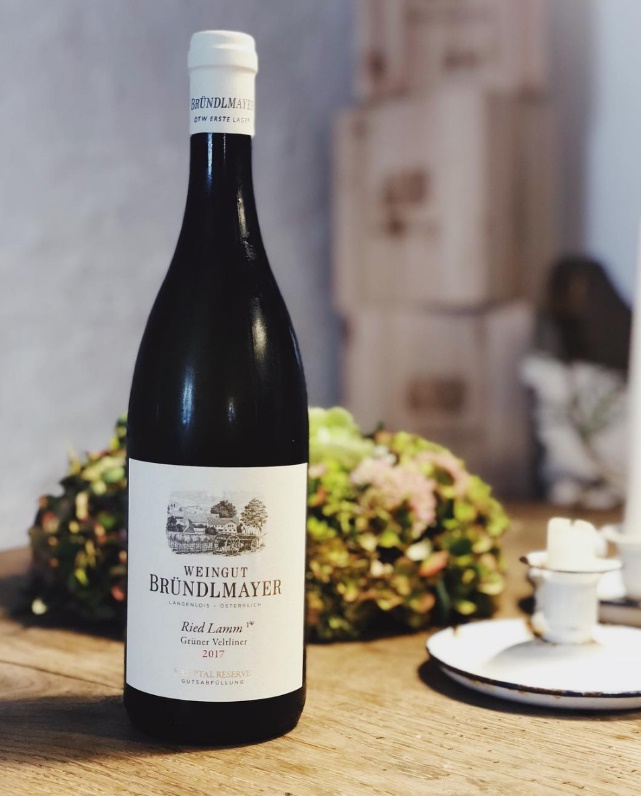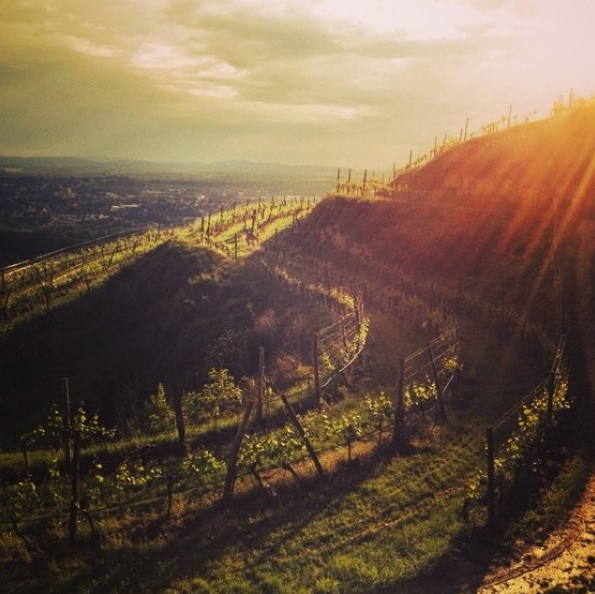“Once again there is pure joy – when the work from an entire wine year is so tasteable in the glass!” It’s the quote that pops up when you land on the Bründlmayer homepage and serves as the mantra of the estate. Certified organic and with an exemplary approach to bottling a pure and unblemished image of its beautiful vineyards, Bründlmayer is as much tangible philosophy as wine business. And doesn’t that philosophy taste good?
We’re delighted to be welcoming Andreas Wickhoff MW to these shores in August. As befits this versatile, visionary, hard-working and erudite family, Andreas is as comfortable in the vineyard and cellar as he is presenting on a panel or pounding Aussie pavements. Coinciding with his arrival, we have a few new releases, such as the latest rendition of the ever seductive Bründlmayer Sekt. (Willi Bründlmayer’s French wife Edwige demanded a sparkling worthy of Champagne if she was going to stick around, so he dutifully obliged.) Joining a splendid range of ’17 Riesling and Grüner Veltliner, we also welcome the Lamm GV and its “almost endless, cool finish of radical minerality,” as Stuart Pigott memorably put it.
 THE WINES
THE WINES
 NV Bründlmayer Sekt RRP $75
NV Bründlmayer Sekt RRP $75
Traditional-method sparkling blend of Pinot Noir, Chardonnay, Pinot Gris, Pinot Blanc and Grüner Veltliner. The grapes are selected in September, when acidity and maturity have reached their perfect point for the base wine for our sparkling production. These grapes are sourced from different chalky parcels in our vineyards, which lends the wine freshness and while most of the sites are southeast-facing slopes, the fruit also receives warmth. The harvested grapes are transported in small cases directly into the cellar, where they are very gently and carefully pressed. Only the heart of the must is used for sparkling production. It ferments in stainless steel where it also undergoes malolactic fermentation before being racked into used 300-litre (or 2500-litre) Austrian oak barrels with about 10% of the lees.
In the following year, the base wine is bottled together with some sugar and yeast for the secondary fermentation. It gets 18 months yeast contact before the process of remuage. During the month-long process of remuage the sediment that forms during secondary fermentation is manoeuvred into the neck of the bottle and up against the cork through riddling from time to time by hand.
Nuances of white bread, brioche and stewed apricot with generous fruit presence – and charm as well; considerable body, firm and open-hearted, very round and juicy, smooth yellow fruitiness, tingling and balanced, not too sweet, very beautiful feel. – Andreas Wickhoff MW, Bründlmayer
2017 Bründlmayer Grüner Veltliner Kamptal Terrassen RRP $39
This Grüner Veltliner is a blend of wines sourced from different terraced vineyards at altitudes of 260m to 380m. The elevated terraces consist of stonier soils (schisted granite). The vines there show aromatic expression, good acidity, elegant stone fruit and lots of minerals. The lower-sited terraces mostly of layered fertile loess show more body and ripeness. By combining those two characteristics Bründlmayer produces a classic Grüner Veltliner with both finesse and a certain vigour. – Andreas Wickhoff MW, Bründlmayer
Kohlrabi, apple, coconut juice, spice. Chalky texture. Good acidity and flavour to go. Lemon peel, cucumber and juicy lemon. Tightens the nuts nicely on the finish, with a bit of pith and crunch to close. Good stuff. 92 points. Gary Walsh, The Wine Front October 2018
2017 Bründlmayer Grüner Veltliner Ried Loiserberg RRP $53
This wine derives from a vineyard on the Loiserberg wherein one also finds the site Berg Vogelsang. The difference is that the Grüner Veltliner from Loiserberg grows on a south to southeast facing slope, which is less exposed to the winds. The soil stems from primary rock geologically defined as zoisite-amphibolite, which is decomposing granite consisting of gneiss, mica-schist, and some clay and loess.
As with the Berg Vogelsang, the grapes are harvested when they are physiologically ripe at the end of October. The wine is fermented at a moderate 15 to 20°C before being racked into large wooden casks for further maturing. Actually, the only difference from Berg Vogelsang is the exposition with slightly higher soil fertility and a marginally warmer, more protected microclimate. Alcohol: 12.5%; RS: dry; total acidity: 6g/L. – Andreas Wickhoff MW, Bründlmayer
Lots of dried-herb and lentil character on the nose. At once powerful and elegant, this is a really sophisticated 2017 Grüner Veltliner that’s more open than many of the top wines of the vintage. From organically grown grapes. Drink or hold. 94 points. Stuart Pigott, jamessuckling.com October 2018
 2017 Bründlmayer Grüner Veltliner Ried Lamm RRP $140
2017 Bründlmayer Grüner Veltliner Ried Lamm RRP $140
The Lamm vineyard has a soil of chalky clay and loess on siltstone. It is a south-facing slope bordering the east of the “Heiligenstein” – one of the warmest sites in our wine growing area.
Grapes from this site reach a high degree of ripeness and concentration, which brings a generous expression more generally associated with Burgundy varieties. “Lamm” is the quintessence of a monumental Grüner Veltliner; it abandons the lightness and prickle that Grüner Veltliner usually stands for.
Physiologically ripe and botrytis-free grapes were harvested in small cases at the end of November at low temperatures and transported as fast as possible into the winery. Grapes are handled carefully without the use of pumps, then slowly and gently pressed to allow some skin contact yet avoiding the transfer of too harsh tannins or cloudy residues into the must.
The must ferments in 2- to 3-year-old 300-litre Austrian oak (and partly new acacia) casks. After fermentation the wine is racked into 2500-litre oak or acacia barrels, together with 5-10% of the lees where it remains until bottling at the end of August of the following year. Alcohol 13%; RS dry; total acidity 6.9g/L.
What a spectrum of aromas, from walnut leaf and ginger to lime and heirloom apple varieties. Even with all its youthful yeasty restraint, crystal clear and bracing. Oak is hardly perceptible this time. Opens beautifully in the glass, sweetly extracted and packing a punch. Despite all the concentration, defined by finesse. Already revealing many layers and even a touch of pineapple on the long aftertaste. Tremendous potential for many years of bottle maturation. – Andreas Wickhoff MW, Bründlmayer
Still slightly funky from long lees contact, this is very deep and complex with an entire universe of herbal and vegetal aromas. Then, an almost endless, cool finish of radical minerality. Made from organically grown grapes. Long aging potential. Drink or hold. 97 points. Stuart Pigott, jamessuckling.com December 2018
2017 Bründlmayer Riesling Kamptal Terrassen RRP $43
This Riesling is a blend of wines sourced from different terraced (therefore high-quality) vineyards. The elevated terraces consist of stonier soils that bring fruit driven wines with mineral nuances and good aging potential. The vines from lower-sited terraces grow partly on layered fertile loess and bring earlier maturing wines that are very expressive in their youth.
By combining those two characteristics, Willi Bründlmayer obtains a Riesling that shows both finesse and a certain vigour. – Andreas Wickhoff MW, Bründlmayer
Delicate peach and nectarine aromas, plus some positive, yeasty character. Medium-bodied with lively acidity, but no rough edges at the long, clean finish. From organically grown grapes. Drink now. Screw cap. 90 points. James Suckling, jamessuckling.com October 2018
2016 Bründlmayer Riesling Kamptal Terrassen RRP $43
One of those fresh and vivacious expressions of Riesling, brisk and crisp, riding on almost lightly fizzy acidity, gentle sweetness but not a sweet wine, a touch of stony-mineral character to finish. Bistro wine extraordinaire! It’s a ripper drink, not overtly complex but definitely overtly drinkable. 93 points. Mike Bennie, The Wine Front April 2019
2017 Bründlmayer Riesling Ried Steinmassl RRP $64
The Riesling vines of the Steinmassl vineyard grow on primary rock with mica-schist. This geological formation of Austria’s southern forest district possesses as classic and traditional a soil type as one is likely to find anywhere Kamptal, Kremstal or Wachau. The vines are partially trained in the lyre-system. The meagre, stony soil provides small berries with concentrated flavour. As far as Riesling is concerned, an important part of the flavour is stored in the grape skins and is set free only by extremely slow pressing of up to 8 hours’ duration or prolonged skin contact overnight. Fermentation is done in stainless steel and maturation is completed on 5 to 10% of the lees. Alcohols 12.5%; RS: dry; total acidity: 7.9g/L. – Andreas Wickhoff MW, Bründlmayer
A totally original dry Riesling form the Danube valley that has a suave and supple feel on the front palate. Then, the firmness from the rocky soil comes through on the cool, lemony finish. From organically grown grapes. Drink or hold. 94 points. Stuart Pigott, jamessuckling.com October 2018
 2017 Bründlmayer Riesling Ried Heiligenstein Lyra RRP $131
2017 Bründlmayer Riesling Ried Heiligenstein Lyra RRP $131
The Bründlmayer family owns 12 hectares right in the centre of the Zöbinger Heiligenstein. 10.5 hectares are planted with Riesling, the remainder for experimental purposes with Cabernet (mostly Cabernet Franc). From a geological point of view Heiligenstein is not only the oldest but probably also the most interesting on our estate: the soil consists of approximately 270 million-year-old Permian desert sandstone. The sediments contain volcanic inclusions and carbonised remains of primeval vegetation. The uniqueness of this soil, its perfect gradient and position (SW to SE in a climatic borderland) provide ideal conditions for growing outstanding wines. During the day warm winds (often due to the effects of the Pannonian climate) climb the site, whereas by nightfall cool gusts from the north start blowing through the Kamp Valley and bring forward the aromatic expression of the grapes.
About 20% of our Heiligenstein vineyards are trained in a lyre trellis system. The vine bifurcates in a way that the branches seem to reach to the heavens like sun-worshippers. This method doubles canopy exposure and favours aeration which improves photosynthesis and prevents dreaded fungus diseases. Yields are restricted by rigorous thinning and although harvest started late only healthy berries without botrytis were brought in. These techniques result in increasing the quality of grapes to show a similar intensity as those deriving from old vines.
We ferment the must in stainless steel at a temperature of 15 to 20° C. After fermentation the wine matures on the lees till bottling in summer. Alcohol 13%; RS: dry; total acidity: 7.7g/L. – Andreas Wickhoff MW, Bründlmayer
The 2017 Riesling Ried Heiligenstein 1ÖTW Lyra is super fine and floral on the highly elegant, balanced nose. Pure but intense and very fine on the palate, this is a highly elegant, complex and very persistent Heiligenstein with remarkable tension, length and salinity. A gorgeous wine and probably one of the finest Austrian Rieslings of the 2017 vintage. 96 points. Stephan Reinhardt, Wine Advocate December 2018
2016 Bründlmayer Riesling Ried Heiligenstein Lyra RRP $111
The fruitiest of Bründlmayer’s 2016 single-vineyard dry Rieslings with a slew of perfectly ripe peach. However, this is still a properly dry wine and it has a very serious structure. The finish is long, intense and bold, but with a wealth of refreshing minerality. Drink now and for many years to come. 96 points. Stuart Pigott, jamessuckling.com October 2017